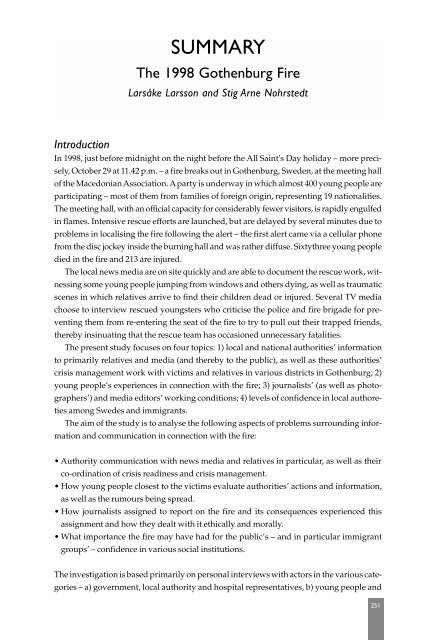Göteborgsbranden 1998 - Myndigheten för samhällsskydd och ...
Göteborgsbranden 1998 - Myndigheten för samhällsskydd och ...
Göteborgsbranden 1998 - Myndigheten för samhällsskydd och ...
Create successful ePaper yourself
Turn your PDF publications into a flip-book with our unique Google optimized e-Paper software.
SUMMARY<br />
The <strong>1998</strong> Gothenburg Fire<br />
Larsåke Larsson and Stig Arne Nohrstedt<br />
Introduction<br />
In <strong>1998</strong>, just before midnight on the night before the All Saint's Day holiday – more precisely,<br />
October 29 at 11.42 p.m. – a fire breaks out in Gothenburg, Sweden, at the meeting hall<br />
of the Macedonian Association. Aparty is underway in which almost 400 young people are<br />
participating – most of them from families of foreign origin, representing 19 nationalities.<br />
The meeting hall, with an official capacity for considerably fewer visitors, is rapidly engulfed<br />
in flames. Intensive rescue efforts are launched, but are delayed by several minutes due to<br />
problems in localising the fire following the alert – the first alert came via a cellular phone<br />
from the disc jockey inside the burning hall and was rather diffuse. Sixtythree young people<br />
died in the fire and 213 are injured.<br />
The local news media are on site quickly and are able to document the rescue work, witnessing<br />
some young people jumping from windows and others dying, as well as traumatic<br />
scenes in which relatives arrive to find their children dead or injured. Several TV media<br />
choose to interview rescued youngsters who criticise the police and fire brigade for preventing<br />
them from re-entering the seat of the fire to try to pull out their trapped friends,<br />
thereby insinuating that the rescue team has occasioned unnecessary fatalities.<br />
The present study focuses on four topics: 1) local and national authorities’ information<br />
to primarily relatives and media (and thereby to the public), as well as these authorities’<br />
crisis management work with victims and relatives in various districts in Gothenburg; 2)<br />
young people’s experiences in connection with the fire; 3) journalists’ (as well as photographers’)<br />
and media editors’ working conditions; 4) levels of confidence in local authoreties<br />
among Swedes and immigrants.<br />
The aim of the study is to analyse the following aspects of problems surrounding information<br />
and communication in connection with the fire:<br />
• Authority communication with news media and relatives in particular, as well as their<br />
co-ordination of crisis readiness and crisis management.<br />
• How young people closest to the victims evaluate authorities’ actions and information,<br />
as well as the rumours being spread.<br />
• How journalists assigned to report on the fire and its consequences experienced this<br />
assignment and how they dealt with it ethically and morally.<br />
• What importance the fire may have had for the public’s – and in particular immigrant<br />
groups’ – confidence in various social institutions.<br />
The investigation is based primarily on personal interviews with actors in the various categories<br />
– a) government, local authority and hospital representatives, b) young people and<br />
251

















